

 |
||||||||||||||||||||
|
||||||||||||||||||||
Celestron Cavalry Binoculars
The Celestron Cavalry series consists of four tough porro binoculars (and one monocular) that are specifically targeted at outdoor adventurers and professionals and in particular for the military, law enforcement, security, hunting, and marine use (boating, sailing etc).
Within this series there is a 15x70 Cavalry binocular for longer range observation and perhaps some astro use, a 10x50 model that is good for general use where low light performance is important, a 7x30 model where compactness and low weight is important, but will also perform well at sea and then this 7x50 model:
Celestron Cavalry 7x50 Binoculars (#71422)
The combination of the 7x magnification, fully water and fogproof body and on-board reticle, digital compass and GPS immediately single this binocular out as potentially perfect for use onboard a ship, boat or yacht in a marine environment, but also with it's very wide field of view should perform very well in many search and rescue type of operations, be that onboard a boat, airplane or helicopter.
I also see it being a very useful binocular for hunters, the military and those involved in security and law enforcement where knowing the exact location and being able to take readings of an objects size or distance away are important.
So how well do they actually work? To find out, take some time to read my complete and very detailed Celestron 7x50 Cavalry Binoculars review that I wrote after many weeks of research, testing and use both in the office and out in the field:
Main Features:
Body Design
Apart from a few modifications to accommodate the LCD screen and battery, the overall shape of these Celestron Cavalry 7x50 binoculars is very typical for that of a porro prism bin with it's eyecups positioned closer together than the objective lenses.
This shape is mostly down to the design of the prism, but the consequence of it is a very comfortable and ergonomic instrument to hold and which is why it has stood the test of time.
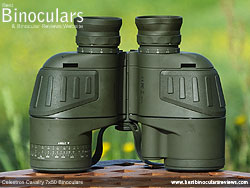 External Covering
External Covering
This Cavalry comes with a rubber armouring that covers the entire exterior. The army green or olive color as Celestron call it is deliberate as this along with the fact that rubber is less reflective than exposed metal or plastic will help keep you concealed which can be important in certain security situations or even when stalking some wildlife.
The rubber itself is about average in terms of it's thickness and hardness and so I would say offers a reasonable amount of impact protection and a good level of protection from sharp edges etc.
This hardness however does mean the surface offers a little less grip than the more soft and spongy armouring that I sometimes see. However to help with this Celestron have placed a more textured and ridged area around the edges of the barrels which continues round to the underside of the device.
I really like the fact that the 50mm objective lenses are deeply set (10mm) into the ends of the barrels. This overhang helps protect the lenses on all bins, but is even more important on marine binoculars like these where not only will it offer shelter from physical damage, dust and rain, but also to a certain extent from sea spray, which does not harm your lenses, but does mark them badly requiring more frequent cleaning which in turn can lead to you damaging or marking the coatings on them..
This deep mounting recess, is similar to the lens hoods you see on expensive cameras and in the same way can help stop or reduce lens flare in some situations.
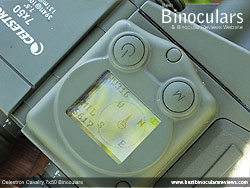 LCD Screen
LCD Screen
Located on the top of the instrument, the LCD screen is used to view the integrated digital compass, GPS and level meter.
This rectangular shaped compartment is 5cm long and 4.5cm wide, with the LCD screen having dimensions of 2cm x 2.6cm.
There are two buttons on the top, one for turning it on/off and the other for cycling through the screens to change mode:
Compass- This screen gives you a digital compass display with readings in both degrees and mils for the bearing that the objective lenses are facing.
The red arrow points in the direction that you are facing when looking through the binoculars and the circle around it rotates to North/South/East/West as you move the binocular.
Remember as this is a digital compass it points to true North as opposed to analogue ones that will point to magnetic North.
GPS - This screen shows you your latitude and longitude coordinates as well as an altitude reading.
Digital Bubble Level - this screen has a large black circle with a small fixed blue circle at its center. A small red circle that represents the "bubble" moves about as you tilt the device. When this bubble is positioned within the small blue circle, the binoculars are level.
Battery Compartment
Positioned on the inside of the right barrel near the objective lens, the instrumentation is powered by a single CR123A battery, one of which is included when you buy the bin.
To access this compartment and insert or replace the battery, you first unscrew the plastic cap and then a brass cover using a coin or screwdriver.
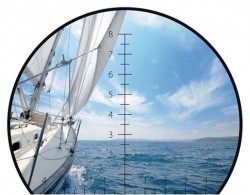 Reticle
Reticle
This Calvary model (71422) as well as two others in the series come with an integrated reticle which you see over the top of the view when looking through the optics and can be used to either estimate distance or size using a couple fairly simple formulas, or as you can see below with the very useful calculator dial that is located on the left barrel of the binocular.
For more on the reticle and the formulas please take a look at my article on Reticle Rangefinders on Marine Binoculars that goes into how to use it in detail.
Reticle Calculator Dial
If like me you don't want to have to remember a formula to calculate distances, Celestron have included a simple, but very handy calculator on the binocular itself.
Positioned on the end of the left barrel (see image below) the reticle calculator dial consists of a angle indicator, a rotating ring and three number scales, which you use by first taking the height reading on the reticle of the object through the optics.
Then for example lets say as you see a man that you estimate as being 6 feet tall (2 yards) as 20 mils tall in the reticle, you then move the rotating ring until number 2 (20mils) lines up with the triangle indicator.
Then if you want to know the distance in feet, you locate the number 6 on the "Object Size" scale. You will see that this then corresponds to 300 on the "Distance" scale, thus the man is 300 feet away.
Or in feet you simply look a the number 2 (for 2 yards tall) on the "Object Size" scale and you will see that it lines up with 100 on the distance scale, meaning the man is about 100 yards away. This same method can be used in metric for meters should you wish.
Don't worry if you don't follow it here, it is actually much easier to understand when you actually use it than for me to explain it!
Chassis
Celestron unfortunately do not go into specifics as to what the main housing is made from, so because they do not highlight it, I will assume that it is a polycarbonate plastic. At this price level this is common and whilst it may not quite match materials like aluminium or magnesium in terms of strength it has the upper hand in the weight department as well as being cheaper to produce.
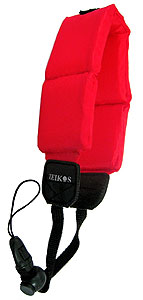 Fog & Waterproof
Fog & Waterproof
Obviously for a marine binocular or indeed any bin that will potentially be used in all types of tough conditions, being able to withstand the elements is vitally important.
Whilst they do not specify a recognized standard, Celestron advertise the Cavalry 7x50 as being both Waterproof and filled with nitrogen gas to make them Fogproof.
What Celestron do not mention is if these bins are buoyant or not. I will assume that the fact that they do not highlight it means that unlike a few marine binoculars, they are not. If this is something that you are concerned with and you feel that you have the possibility of dropping them overboard, then you should consider getting yourself a floating neck strap that will keep your optics on the surface long enough for you to rescue them.
Tripod Adaptable
The relatively low 7x power on this Cavalry not only helps ensure you get a really wide view, but also makes it just that bit easier to keep the image you see still.
However for a completely stable view or for those who want to keep the bin trained onto a specific point, you can also quite easily fix these to a tripod.
All you have to do is simply unwind the dust cap on the front face of the central hinge. This then reveals a standard sized thread, which you then thread a binocular tripod adapter into. You then connect this adapter either straight onto your tripod, or to your tripod head depending on your setup.
Focusing
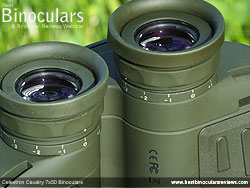 Unlike the other models within the Celestron Cavalry binocular range that all have a standard central focusing wheel, this 7x50 model uses a individual focus system and is thus essentially a fixed focus binocular.
Unlike the other models within the Celestron Cavalry binocular range that all have a standard central focusing wheel, this 7x50 model uses a individual focus system and is thus essentially a fixed focus binocular.
Binos with this "system" are sometimes rather confusingly referred to as auto focus binoculars, but what it basically means is that they have a separate diopter adjustment on each eyepiece and so once you have set both of them to match that of your eyesight, the binocular will remain in focus to infinity without any further adjustments necessary.
Thus whilst it may take a little longer when you first set-up your binoculars, they are often far quicker to use from that point on because no further focussing is ever needed.
The one downside to fixed focus binoculars is that because they have such a long depth of view, their minimum close focusing distance is usually much further away than what you get with a standard focusing instrument. For example, this Celestron Cavalry 7x50 Marine binocular has a minimum focus of 32.7ft / 10m which is not bad, but if you compare it to the average "normal" full sized bin that can focus on an object from about 7ft / 2m, you can see the difference is vast.
So that is why fixed focus binoculars are not usually recommended for anyone who may want to view objects from closer distances (butterflies, insects and even some birding or wildlife observation). However if you never really need to look at nearby objects this really is not an issue and so for some types of longer distance birding and wildlife observation as well hunting, security, military and especially marine uses like search and rescue, sailing and boating where being able to quickly locate a target or ease of use is far more important then this setup is far more desirable.
Eyepieces & Diopter Adjustment
Ok, so now that we have established that constant focusing is not necessary, but to initially set up the binoculars you need to adjust the diopters. This is really simple and indeed pretty much the same as on most "normal binoculars", except instead of the one eyepiece you adjust both of them.
I found that both diopters turned smoothly without any free play, but with enough resistance to stop them from easily being moved by accident.
Celestron do not mention what they are fashioned from and with the rubber armour on top of them it is difficult to tell, but the eyepiece housings look and feel robust and should not easily be broken.
I like the fact that there is a printed scale for each diopter that makes it quicker to return to your setting should you need to move when sharing your binocular or if by accident.
The Eyecups
Like many bins of this design, the Celestron Cavalry has rubber Roll-Up/Down eyecups. Because the rubber is very soft and they have a very large 46mm diameter, they make for very comfortable viewing and do a great job of blocking out external light from entering from the sides.
However because they are so big and so soft, as you can see from the photos they do get a little out of shape when you leave the bin laying on it's side. This is not really a problem, rather just an aesthetic issue and they do return to their normal circular shape after a while.
This 7x50 Celestron Cavalry binocular sports a super long 23mm eye-relief which will most certainly allow almost all those with eyeglasses or even goggles on to use them and still be able to observe the full image.
Non eyeglass users will simply use them with the eyecups in their standard position, but if you do wear glasses, you simply roll down the eyecup and thus get your eyes (with your glasses on) to the correct distance behind the ocular lens.
The main reason I usually prefer a twist-up/down eyecup to a fold-up/down one is that you can fine tune the extension of the eyecup to perfectly suit your particular needs, whilst with most folding ones, it is either all or nothing.
However on this one Celestron have added a folding crease into the rubber for added flexibility, which means you can fold them down to halfway (Left Image below) or again to fully retracted (right image below) which is excellent and shows some good attention to detail.
Adjusting the Interpupillary Distance (IPD)
By opening and closing the central hinge you can move the ocular lenses and their eyecups further apart or closer together to match the distance between your particular eyes (interpupillary distance (IPD))
This Celestron Marine binocular has a maximum IPD of 7.2cm and a minimum of 5.8cm, which is a good range and thus they should be able to be used by most people.
Rating for Body Construction Quality: 8/10
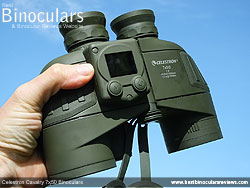 Dimensions
Dimensions
The advertised length is 5.8in / 14.6cm which I can confirm as being correct, although if you add the lens covers and rain-guard this does move out a little more.
The advertised width is 7.8in / 19.8cm, which is taken with the central hinge fully open (Max IPD), by closing the hinge the minimum width is possible is 18.6cm
The official height is shown as 3.2in / 8cm which is correct when you close the hinge, by opening it it reduces to about 7cm.
To give you an idea of where these dimensions sit, you can see that when compared to most standard sized 42mm roof prism bins, these are a fair bit more bulky. Apart from the different porro prism design which always makes for a less compact shape than roof prism bins, this extra size is to be expected due to the use of larger 50mm lenses.
However compare them to other 50mm porro prism marine binoculars like the Minox, Bushnell, Nikon, Vortex and Fujinon below, you can see that these are quite compact and whilst they may be bigger than a 30mm marine binocular like the Steiner below, the much larger objective lenses will give you a far better optical performance, especially in bad light.
| Length | Width | Depth | Weight | |
| Celestron Cavalry 7x50 | 5.8in / 14.6cm | 7.8in / 19.8cm | 3.2in / 8cm | 31.5oz / 893g |
| Minox BN 7x50 C Nautic | 6.4in / 16.3cm | 8.8in / 22.3cm | 3in / 7.8cm | 35oz / 980g |
| Bushnell 7x50mm Marine | 7.4in / 19cm | 7.5in / 19cm | 37oz | |
| Fujinon Polaris 7x50 FMTR-SX | 7.9in / 20cm | 8.6in / 22cm | 53.6oz | |
| Nikon 7x50mm OceanPro | 7.6in / 19.3cm | 8in / 20cm | 39.3oz | |
| Vortex Hurricane 7x50 | 7.4in / 19cm | 8in / 20cm | 39.4oz | |
| Steiner 7x30 Navigator Pro Marine | 4.6in / 11.7cm | 6.8in / 17.3cm | 2.2in / 5.6cm | 20oz / 567g |
| 42mm Roof Prism Bins | ||||
| Celestron Granite 8x42 | 5.8in (14.7cm) | 4.0in (10.3cm) | 2.1in (5.3cm) | 24oz (680g) |
| Celestron 8x42 Nature | 5.7in (14.4cm) | 4.3in (11cm) | 2.1in (5.3cm) | 27 oz (765 g) |
Weight
Likewise their weight of 31.5oz (893g) compares very favourably with other similar devices, but is a little heavier than a standard binocular that you may be more familiar with.
As a point of interest I measured the weight of this Celestron Cavalry 7x50 binocular at 882g which included the battery and objective lens covers, but without the rain-guard and neck strap which is a little lighter than their official weight.
BBR Rating for Body Stats compared to other 50mm Marine Bins: 9/10
Ocular Lenses
Celestron do not go into specifics regarding the make-up of the ocular lenses and so all I can report is that they have a 23mm diameter which is nice and large.
Objective Lenses
Once again, Celestron do not go into detail when describing their objective lenses, so I cant comment on the details of each element. However the large 50mm objective lenses have the potential to capture more light than your standard 42mm bin and when you combine this with their slightly lower 7x magnification you get a really large 7.1mm (50 ÷ 7 = 7.1) exit-pupil or to put it another way, the shaft of light that exits the eyepiece to go into your eye is 7.1mm in diameter.
A large exit pupil firstly makes it much easier for you to line your eyes up correctly in the eyecups and so makes them quicker and easier to use and you get much less chance of dark rings forming around the edges of the view.
Secondly it means that even in poor light conditions when the pupils in your eyes have dilated, this binocular will supply them with more than enough light for you to see a nice and bright image and thus these will potentially perform better low light than those with a smaller exit pupil.
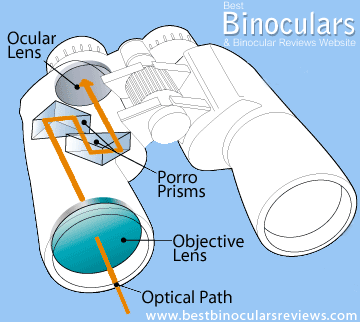 Prisms
PrismsThese and indeed all Celestron Cavalry binoculars use porro prisms inside of them to rectify the inverted image and whilst they may make for a less compact shape than that of most roof prism bins, they also have a number of key advantages.
Firstly because the objectives are positioned slightly further apart than on most roof prism bins, you get an improved stereo type of effect which leads to a better perspective and sense of depth in the view.
To match the performance of a porro prism, roof prism binoculars also require a number of very specialized treatments and coatings as they have one surface which does not completely reflect all the light that hits it and they also cause the light to become out of phase. These coatings and treatments are expensive and so to achieve the same performance a roof prism will cost more than a porro prism.
The prism on these Celestron Cavalry 7x50 binoculars is fashioned from "high grade" BaK-4 glass that because of it's properties, is generally deemed to be superior to that of BK7 glass when used in a binocular.
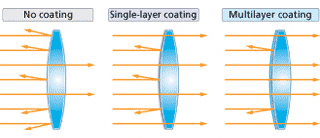 Anti-Reflection Coatings
Anti-Reflection Coatings
To maximize the amount of light that can be potentially captured by the objective lenses and then transmitted to your eyes, most binoculars will have a layer or layers of anti-reflection material added to some or all of the glass surfaces throughout the optical system.
Cheap optics are often just coated or multi-coated, which means that they contain either a single layer of this material on some of the glass surfaces. Whilst better quality optics like these Celestron Cavalry binoculars are Fully Multi-Coated, meaning they have these coatings applied to every single glass surface throughout the optical system.
When you consider that most binoculars have around 10 to 18 glass surfaces, all of which could negatively reflect light, you will understand why this is important and really does make an observable difference to both the quality and brightness of the image that they deliver:
| Transmittance Levels | |||
| Per Single Lens Surface | 10 Lens & Prism Surfaces | Transmittance % | |
| No Coating: | 96% | (0.96) x 10 = 0.66 | 66% |
| Single-Coating: | 98.5% | (0.985) x 10 = 0.86 | 86% |
| Multi-Coating: | 99.5% | (0.995) x 10 = 0.95 | 95% |
Optical Components Quality Rating: 7/10
The Field Of View (FOV)
The two main reasons for decreasing the magnification a little on a marine type binocular like these is firstly to make the image more stable and easier to use, which is especially important if you are on an unstable platform like a boat, yacht, vehicle or aeroplane etc.
Secondly it helps you achieve a far wider view, which is super important if you want to be able to quickly locate a target, easily follow it (if it is moving fast or erratically) and it also makes scanning large areas when looking for something much easier. As you can imagine in many search and rescue, security, military and hunting scenarios is also far more important than the small amount of image detail that you loose with the reduced magnification.
These Celestron 7x50 Cavalry binoculars have an angle of view of 7.5°, or to describe it in another way, the view you see is 131 meters wide at a distance of 1,000 meters away (394ft at 1,000 yards).
As you can see from the table below this is very wide when you compare it many other 7x porro prism marine binoculars on the market. Indeed it is only the $800 Fujinon Polaris that beats it:
| FOV at 1000yds | Near Focus | Eye-Relief | |
| Fujinon Polaris 7x50 FMTR-SX | 430ft | 17ft | 23mm |
| Celestron Cavalry 7x50 | 394ft | 32.7ft | 23mm |
| Vortex Hurricane 7x50 | 378ft | 30ft | 17mm |
| Nikon 7x50mm OceanPro | 378ft | 33ft | 22.7mm |
| Minox BN 7x50 C Nautic | 369ft | 23ft | 18mm |
| Steiner Navigator 7x30 Marine | 369ft | 66ft | 20mm |
| Bushnell 7x50mm Marine | 350ft | 35ft | 18mm |
Near Focus
As I have already discussed one of the downsides to the fixed focus system is that to achieve the very long depth of view, the minimum close focusing distance is substantially larger to that of most adjustable focus binoculars. However once again as you can see from the comparison table above these 7x50 Cavalry's compare very favourably to others of their type.
Eye-Relief:
With a massive 22mm, I would describe theses as having a very long eye-relief, and thus offer the user plenty of manoeuvrability to get your eyes the correct distance behind the ocular lenses and are thus an ideal choice for those who use eyeglasses whilst binning.
Optical Stats Rating compared to other 7x Marine Binoculars: 8/10
For almost all of my reviews I use a similar configured binocular as that which is under review as a benchmark to compare the views with. In this way I am able to then rate and rank them in relation to all the others that I have tested in the past. However as the 7x50 setup is somewhat out of the ordinary, I do not as of yet have a benchmark version.
Thus the observations below are based on my experience and for interest I also decided to compare the views between this Celestron Cavalry 7x50 and that of my benchmark 8x42 bin:
Color Reproduction
To my eyes the colors in the image look vibrant, but still natural and without any sort of artificial tinting that I sometimes see, especially where cheap glass is used in the lenses and prisms.
Contrast
Whilst the image produced by these Celestron binoculars is generally very bright (see below), it is not at all "washed out" and you still get a good level of contrast between dark and light.
Image Brightness & Low Light Performance
Whilst the quality of the workmanship, glass and the coatings that are used play an important role in determining how much light gets transmitted through the optical system and into your eyes, the initial configuration of a binocular plays the biggest part in determining how bright an image we see, especially in low light.
So 7x50 binoculars like this one have an exit-pupil of 7.1mm (50 ÷ 7), which is nice a nice and large shaft of light exiting the eyepiece and onto your eyes. For example compare this to an 8x42 which has a 5.25mm (42 ÷ 8) exit pupil and is still considered to be a good choice for low light use.
So as expected (because of their good quality optics and their setup), I found the image produced by these Celestron's to be nice and bright, which became especially apparent in poor to very poor light conditions where I could see a real improvement between these and my 8x42 binoculars.
Softening
With almost all binoculars, you can see an area all around the very edge of the view that is a little fuzzy and out of focus. This amount is very minimal to none on the best binoculars, which I have to say was pretty much the case with these.
One point of interest is that I thought that there was slightly more softening through the right barrel than the left. I am not at all sure, but perhaps this is down to the reticle being imprinted on the glass on this side, but whatever the case, the amount is still very small and nothing to be concerned about.
Color Fringing
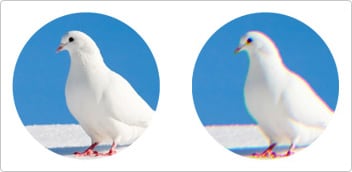 The extra long close focus distance on these Celestron Cavalry Binoculars made finding any signs of color fringing (the result of Chromatic Aberrations) a little harder than norma.. which is a good thing! This is because I usually focus on the edges of an objects that has a high contrast to it's background a few meters away as this tends to make it easier to spot than further away in the distance.
The extra long close focus distance on these Celestron Cavalry Binoculars made finding any signs of color fringing (the result of Chromatic Aberrations) a little harder than norma.. which is a good thing! This is because I usually focus on the edges of an objects that has a high contrast to it's background a few meters away as this tends to make it easier to spot than further away in the distance.
However in extreme cases, like where one side of a tree's trunk is in full sunlight and the other is in full shade and you carefully look at it's edges against a bright sky, I was able to see a minimal amount of color fringing. However this is really negligible and really nothing that you should be overly concerned about as you will only ever notice it if you are actively looking for it.
Image Quality Rating: 8/10
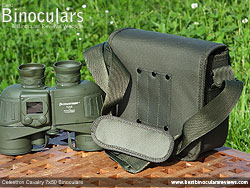 Carry Case
Carry Case
The army green Celestron carry case that you get with these 7x50 Cavalry's matches the bins nicely in terms of color and is of a semi rigid design and looks to be mostly made from a tough canvas type of material.
To me it looks very well made with good stitching and edging and so should last. The bag comes with it's own un-padded strap, however it has a sliding shoulder pad for added comfort and can be adjusted for length with the buckles.
On the rear of the bag is also a loop that enables you to attach the bag to your hip by threading your belt through it should you wish to carry it this way.
The lid that folds over the top of the case is held shut with a strip of Velcro. Whilst this does a decent job of keeping it closed and is quick to open and close, it is not quite as secure as those that have a Zip. You also have to be careful when opening it if you want to remain unheard, which in certain security and military situations can be very important.
The internal padding is perhaps not quite as soft as it could be, so probably provides a little less cushioning than on some, but it should still be sufficient for all but the heaviest thumps.
Inside there is also a single elasticated pocket that is a good place to keep a few small items as well as your cleaning cloth.
The binoculars fit perfectly into the bag and it is still easy to close the lid with all lens covers attached to the instrument, which believe it or not, I find is not always the case.
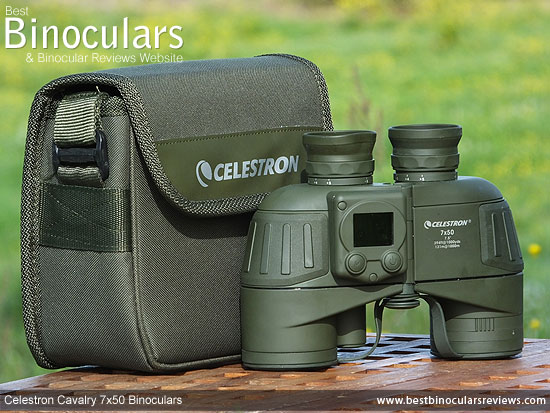
Neck Strap
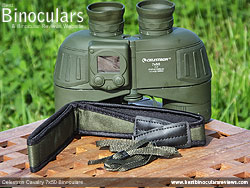 I would say that out of the included accessories, the neck strap is probably the weakest link. Whilst it is in no ways bad and works just well enough, I would describe it as being rather basic and lacks some of the finesse that you get with better ones.
I would say that out of the included accessories, the neck strap is probably the weakest link. Whilst it is in no ways bad and works just well enough, I would describe it as being rather basic and lacks some of the finesse that you get with better ones.
Whilst the green color matches that of the binocular, the strap looks quite generic and lacks any sort of branding, which for some people this is considered a good thing.
The stitching on my set looked good, without any loose ends and should hold together without any issues, this includes the often troublesome area of the connector between the thin and padded part of the strap. This connector is made from faux leather, which is quite common at this price point.
The padded neck section is quite thin, both in it's width (4cm) and it's depth (5mm) which in my opinion is just a little under padded for a binocular of this size and weight. It is also not curved as some are to better fit around your neck and shoulders.
The thin strap section fixes to the binocular in the usual way by threading it through the loops on each side of the body of the binocular and then back on itself through a slider which enables you to adjust it's length.
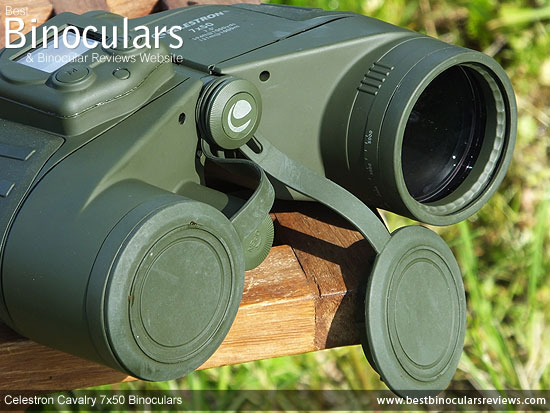
Lens Covers
I really like the soft rubber/plastic objective lens covers that you get on this Celestron Cavalry 7x50 binocular. They fit really nicely into the ends of the barrels, which offers a far cleaner and more streamlined look than those that fit over the top of them
The fit itself was also good on my test pair, being just secure enough so that they don't inadvertently come away too easily, but also not so close that it makes replacing them a pain.
I also really like the way that they are attached to the central pivot under the dust cap. This system allows the to hang below the binocular when you are glassing, but are always at hand and easy to replace once you are done.
Many tethered lens covers use a loop that connects them to each barrel, which works as well, but once again is not quite as "clean" looking as this solution.
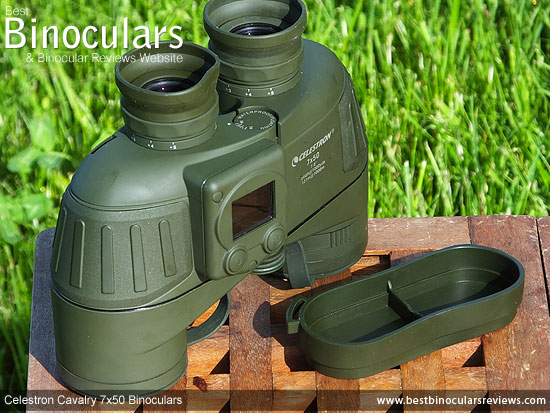
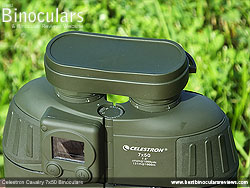 Rain Guard
Rain Guard
This simple soft plastic cover known as a rain guard sits over the eyecups to protect the ocular lenses when not in use.
The design of this one is quite common on porro prism binoculars with roll up/down eyecups and whilst it fits well enough when you have the IPD set to maximum (central hinge fully open), I found that it would quite easily come away if the eyecups are positioned closer together. So to ensure that it does not easily come away you have to open the hinge up every time, which is not a deal breaker, but can be a little annoying if you are having to do this often.
There is a single loop on one side that you can thread the neck strap through to keep it always at hand should you wish.
Lens Cloth
The cleaning cloth is of a decent standard and for me is adequate for storing in your carry case for keeping the body clean or very occasional and emergency use on the lenses when out in the field. However should you want to clean the lenses correctly and not potentially scratch or damage the coatings, I would still get a proper optical cleaning kit.
Instructions & Warranty Information
The main instructions come in the form of a small booklet and as is usually the case, it is written in a number of languages. It is rather generic as it covers all models within the Celestron Cavalry range, but is still a little more substantial than most that I see. Topics include all the important basics like naming the parts of the bin, adjusting the IPD, diopter adjustment, eyecups, tripod adaptability, care, storage cleaning as well a large and in-depth section on using the reticle.
Celestron Optics have included a separate booklet that explains all the functions and features of the built-in LCD screen that comes on this model (71422).
At the end of the main instructions is a section that includes all the details of the excellent lifetime warranty.
Extras & Attention to Detail Rating: 7/10
To give you some idea as to how the features and specifications compare to other similar marine binoculars on the market, I have included the comparison table for you below:
| Celestron Cavalry 7x50 | Bushnell 7x50 Marine | Fujinon Polaris 7x50 FMTRC-SX | Minox BN 7x50 C Nautic | Nikon 7x50 OceanPro | Steiner Navigator 7x30 Marine | |
| Approx Price: | $180 / £250 | $200 / £250 | $600 / £800 | $250 / £200 | $300 / £280 | $300 / £200 |
| Compass | Yes, Digital External | Yes, Digital Internal | Yes | Yes, Analogue Internal | Yes, Internal | Yes, Digital Internal |
| GPS | Yes, Digital | No | No | No | No | No |
| Level | Yes | No | No | No | No | No |
| Reticle | Yes | Yes | Yes | Yes | Yes | Yes |
| Calculator Dial | Yes | No | No | No | No | No |
| Weight: | 31.5oz (893g) | 37oz | 55oz | 35oz / 980g | 39.3oz | 20oz / 567g |
| Length: | 5.8in / 14.6cm | 7.4in / 19cm | 7.9in | 6.4in / 16.3cm | 7.6in / 19.3cm | 4.6in / 11.7cm |
| Width: | 7.8in / 19.8cm | 7.5in / 19cm | 8.6in | 8.8in / 22.3cm | 8in / 20cm | 6.8in / 17.3cm |
| Magnification: | 7x | 7x | 7x | 7x | 7x | 7x |
| Objectives: | 50mm | 50mm | 50mm | 50mm | 50mm | 30mm |
| Exit Pupil | 7.1mm | 7.1mm | 7.1mm | 7.1mm | 7.1mm | 4.3mm |
| Eye Relief: | 23mm | 18mm | 23mm | 18mm | 22.7mm | 20mm |
| Near Focus: | 32.7ft | 35ft | 20ft | 23ft | 33ft | 66ft |
| FOV at 1000yds: | 394ft | 350ft | 430ft | 369ft | 378ft | 369ft |
| Prism Type | Porro | Porro | Porro | Porro | Porro | Porro |
| Prism Glass | BaK-4 | BaK-4 | BaK-4 | BaK-4 | BaK-4 | BaK-4 |
| ED Glass | No | No | No | No | No | No |
| Lens Coatings | Fully Multi-Coated | Fully Multi-Coated | Fully Multi-Coated | Fully Multi-Coated | Multi-Coated | ? |
| Waterproof | Yes | Yes | Yes | Yes | Yes | Yes |
| Buoyant | No | Yes | No | No | Yes | No |
| Fogproof | Yes | Yes | Yes | Yes | Yes | Yes |
| Tripod Adaptable | Yes | Yes | Yes | ? | Yes | ? |
What is immediately obvious is that not only do these Celestron Cavalry binoculars very competitively priced, but they equal or beat most of their competitors main specifications. It also comes with far more in built military/marine like features (reticule, reticle scale, digital GPS, compass and bubble level) than almost any other similar bin out there.
Strong Points:The body of these Celestron Cavalry 7x50 binoculars looks and indeed feels very well made, they have a nice balance to them when you are glassing and you really do feel like you have a high quality optical instrument in your hands.
The GPS, compass and range finding reticle are simple to use and work as they should. What is more the inclusion of all these as well as the digital bubble level means that this bin is more feature rich than pretty much all of it's direct competitors. I also really like the addition of the reticle calculator dial on the barrel, which really makes working out distances far easier, thus making the reticle far more useful to me and shows a good attention to detail from Celestron.
I thought that both the quality and brightness of the view was excellent and is easily up there with the best in this type of bin and price range.
The very long eye-relief is excellent and really important to those eyeglass wearers and whilst I usually far prefer twist up/down eyecups, the very soft rubber and twin position fold up/down cups on these are not only very comfortable to use, but block out more unwanted lateral light and provide the user with enough options to get their eyes to match the eye-relief, with or without glasses.
Their field of view is also very good when you compare it to other 7x porro prism binocular in this class. This is very important in being able to quickly locate something in your view, follow it, if it is fast or erratic moving and also really helps when scanning over large areas whilst searching for something or someone. In many search and rescue, marine, military, security and hunting scenarios this feature cannot be under estimated.
The objective lens covers are excellent. The fit very well into the ends of the barrels making for a very clean and tidy appearance and are easy to fit, yet don't come away too easily as is the case on may others. I also like the way they are tethered to the central pivot so as to be always at hand when needed, but will hang out of the way when glassing.
Weak points? A trade off to the speed of not having to focus the binocular on a fixed focus instrument like this is most certainly the long minimum focusing distance. Compared to other fixed focus bins these are about average but when compared to normal focusing binoculars this is poor. So if you do often observe objects at distance of 10 meters or less then this will most certainly be problem and probably not the right type of binocular for you.
Whilst it is not terrible, I thought that the neck strap was a little basic, thin and under padded for a binocular of this calibre and weight.
Likewise I also think the rainguard is just a bit to simple, sure it works well enough and not a major issue, but it would be nicer if they could come up with a better design so that they remain more securely in place when the bins are not set at the maximum IPD.
As I have mentioned in the strong points, the very large eyecups are made out of a very soft rubber, this is great for comfort and blocking out external peripheral light sources that can spoil the view a little. However they also tend to get misshapen and whilst this in no way affects their performance and after a while they do go back into place, aesthetically it just looks a little wrong.
Overall
I think for their low selling price you get an excellent value for money binocular. It is well made using good quality optics and components to deliver a tough workhorse with a bright and high quality view. With a digital GPS, bubble level, compass as well as a reticule and calculator scale it has more marine type features than all it's competitors and it's main specifications are up there with the best within it's field. So whilst it not targeted to the general use and mainstream users, it is the perfect instrument to be used in a number of more specialised areas and is for my money one of the best value for money, full featured marine binocular currently on the market:
Ideal Uses: As I thought before testing these and wrote at the beginning of this review, the "more stable" 7x magnification, along with the fog and water and body, reticle, digital compass and GPS make set this Celestron Cavalry out as an ideal marine binocular.
If you add to that the very wide field of view that ensures you can find and follow objects easier, then these will also be ideal for search and rescue operations, and so I can see them being perfect for lifeguards, both on the shore and onboard boats, planes or helicopters.
All these features above along with the larger 50mm objectives that ensure an excellent low light performance also lead me on to describe the Celestron 7x50 Cavalry binocular as potentially being a very useful tool for some for hunters, many uses in the military and those involved in security and law enforcement where being able to get a lock on your exact location as well as take readings of an objects size or distance away from you are important.
100% Real Review
This Celestron 7x50 Cavalry binocular review is completely genuine. I fully researched, used and tested the instrument and the opinions that I have expressed on this page are completely honest. Like all the others on BBR, I do not get compensated for or asked to write in a particular way or with some sort of slant or bias. If I think something is good, I say so and if it is bad, it will also be h
Reviewed by Jason Whitehead for Best Binocular Reviews
|
Main Specifications & Features:

General Price Range: (3/6) Mid Price Binoculars
Below is a link that will take you to a page with online retailers in both the US and UK that sell Celestron 7x50 Cavalry Binoculars this page makes it easy to compare prices and then to buy from your preferred option:
|
Buy & Compare Prices for the Celestron 7x50 Cavalry Binoculars |
||
US Shoppers |
Canadian Shoppers |
UK Shoppers |
Deutsch Shoppers |
Aussie Shoppers |
Indian Shoppers |

